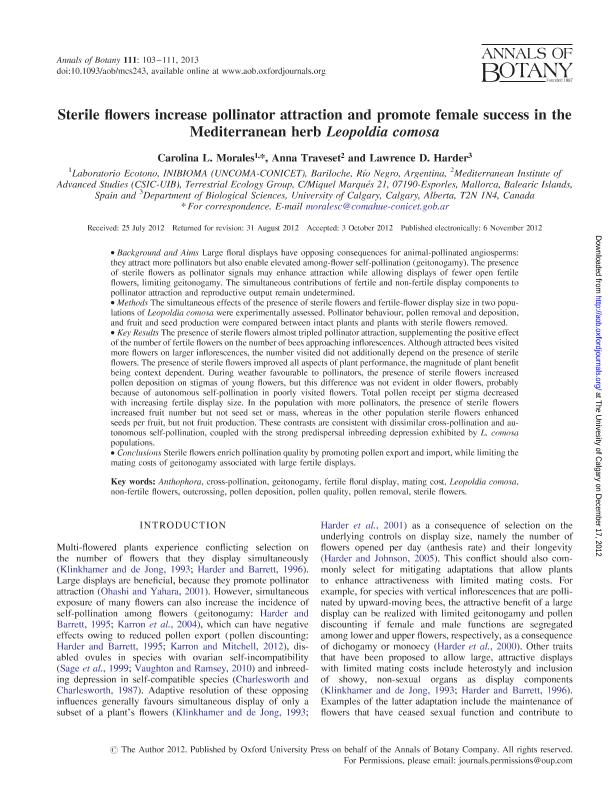Artículo
Sterile flowers increase pollinator attraction and promote outcrossing in the Mediterranean herb Leopoldia comosa
Fecha de publicación:
01/2013
Editorial:
Oxford University Press
Revista:
Annals of Botany
ISSN:
0305-7364
Idioma:
Inglés
Tipo de recurso:
Artículo publicado
Clasificación temática:
Resumen
Background and Aims Large floral displays have opposing consequences for animal-pollinated angiosperms: they attract more pollinators but also enable elevated among-flower self-pollination (geitonogamy). The presence of sterile flowers as pollinator signals may enhance attraction while allowing displays of fewer open fertile flowers, limiting geitonogamy. The simultaneous contributions of fertile and non-fertile display components to pollinator attraction and reproductive output remain undetermined.
Methods The simultaneous effects of the presence of sterile flowers and fertile-flower display size in two populations of Leopoldia comosa were experimentally assessed. Pollinator behaviour, pollen removal and deposition, and fruit and seed production were compared between intact plants and plants with sterile flowers removed.
Key Results The presence of sterile flowers almost tripled pollinator attraction, supplementing the positive effect of the number of fertile flowers on the number of bees approaching inflorescences. Although attracted bees visited more flowers on larger inflorescences, the number visited did not additionally depend on the presence of sterile flowers. The presence of sterile flowers improved all aspects of plant performance, the magnitude of plant benefit being context dependent. During weather favourable to pollinators, the presence of sterile flowers increased pollen deposition on stigmas of young flowers, but this difference was not evident in older flowers, probably because of autonomous self-pollination in poorly visited flowers. Total pollen receipt per stigma decreased with increasing fertile display size. In the population with more pollinators, the presence of sterile flowers increased fruit number but not seed set or mass, whereas in the other population sterile flowers enhanced seeds per fruit, but not fruit production. These contrasts are consistent with dissimilar cross-pollination and autonomous self-pollination, coupled with the strong predispersal inbreeding depression exhibited by L. comosa populations.
Conclusions Sterile flowers enrich pollination quality by promoting pollen export and import, while limiting the mating costs of geitonogamy associated with large fertile displays.
Archivos asociados
Licencia
Identificadores
Colecciones
Articulos(INIBIOMA)
Articulos de INST. DE INVEST.EN BIODIVERSIDAD Y MEDIOAMBIENTE
Articulos de INST. DE INVEST.EN BIODIVERSIDAD Y MEDIOAMBIENTE
Citación
Morales, Carolina Laura; Traveset, Anna; Harder, Lawrence D.; Sterile flowers increase pollinator attraction and promote outcrossing in the Mediterranean herb Leopoldia comosa; Oxford University Press; Annals of Botany; 111; 1; 1-2013; 103-111
Compartir
Altmétricas




